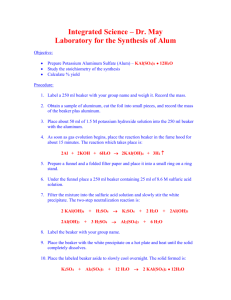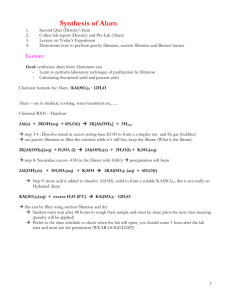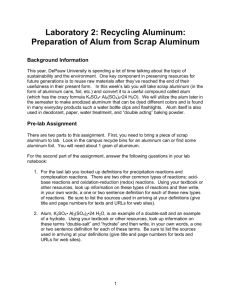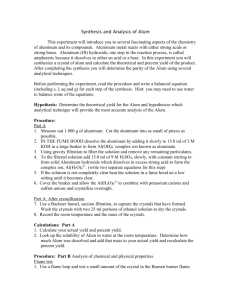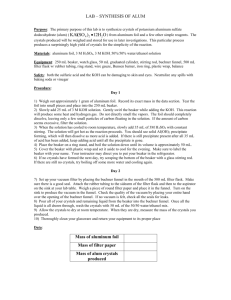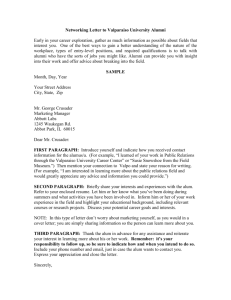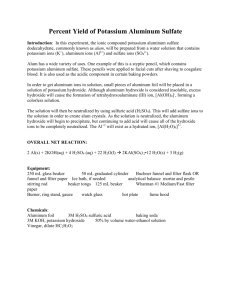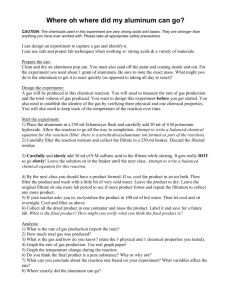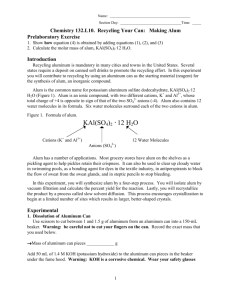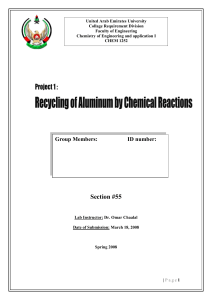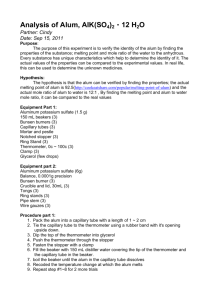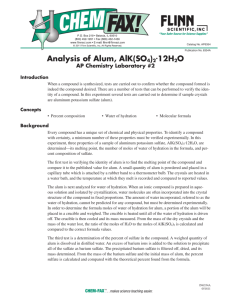EXPERIMENT 8 Synthesis of Alum from Al Metal
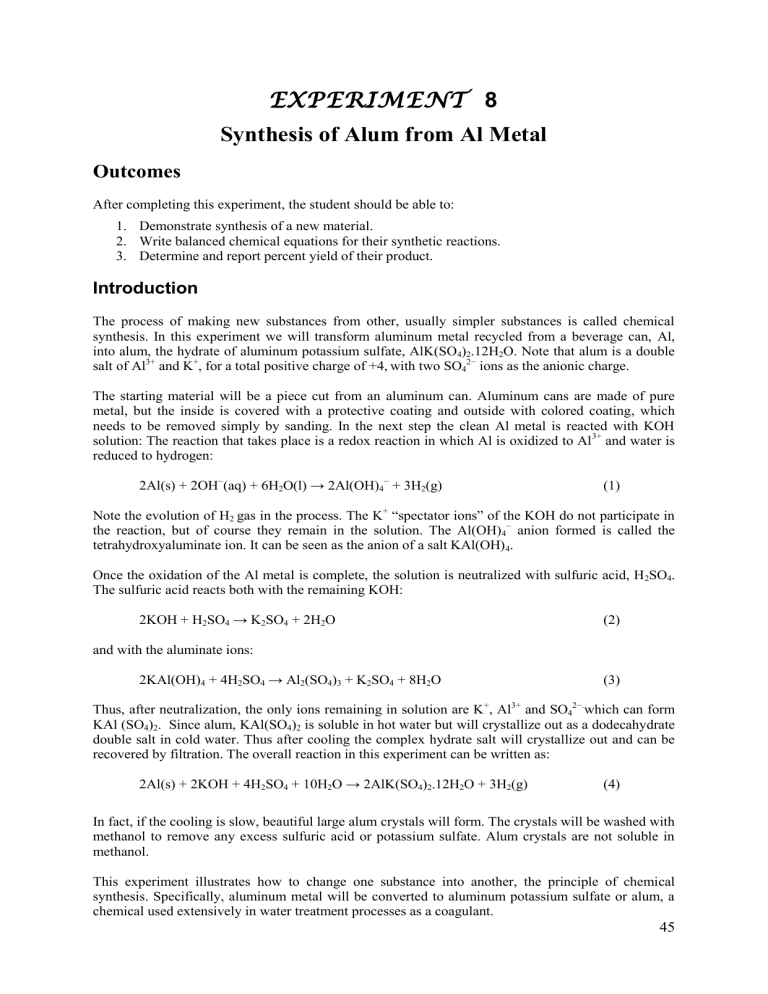
EXPERIMENT
8
Synthesis of Alum from Al Metal
Outcomes
After completing this experiment, the student should be able to:
1.
Demonstrate synthesis of a new material.
2.
Write balanced chemical equations for their synthetic reactions.
3.
Determine and report percent yield of their product.
Introduction
The process of making new substances from other, usually simpler substances is called chemical synthesis. In this experiment we will transform aluminum metal recycled from a beverage can, Al, into alum, the hydrate of aluminum potassium sulfate, AlK(SO
4 salt of Al
3+
and K
+
, for a total positive charge of +4, with two SO
4
)
2
.12H
2−
2
O. Note that alum is a double
ions as the anionic charge.
The starting material will be a piece cut from an aluminum can. Aluminum cans are made of pure metal, but the inside is covered with a protective coating and outside with colored coating, which needs to be removed simply by sanding. In the next step the clean Al metal is reacted with KOH solution: The reaction that takes place is a redox reaction in which Al is oxidized to Al
3+
and water is reduced to hydrogen:
2Al(s) + 2OH
−
(aq) + 6H
2
O(l) → 2Al(OH)
4
−
+ 3H
2
(g) (1)
Note the evolution of H
2 gas in the process. The K
+
“spectator ions” of the KOH do not participate in the reaction, but of course they remain in the solution. The Al(OH)
4
−
anion formed is called the tetrahydroxyaluminate ion. It can be seen as the anion of a salt KAl(OH)
4
.
Once the oxidation of the Al metal is complete, the solution is neutralized with sulfuric acid, H
2
SO
4
.
The sulfuric acid reacts both with the remaining KOH:
(2) 2KOH + H
2
SO
4
→ K
2
SO
4
+ 2H
2
O and with the aluminate ions:
2KAl(OH)
4
+ 4H
2
SO
4
→ Al
2
(SO
4
)
3
+ K
2
SO
4
+ 8H
2
O (3)
Thus, after neutralization, the only ions remaining in solution are K
+
, Al
3+
and SO
4
2−.
which can form
KAl (SO
4
)
2
. Since alum, KAl(SO
4
)
2
is soluble in hot water but will crystallize out as a dodecahydrate double salt in cold water. Thus after cooling the complex hydrate salt will crystallize out and can be recovered by filtration. The overall reaction in this experiment can be written as:
2Al(s) + 2KOH + 4H
2
SO
4
+ 10H
2
O → 2AlK(SO
4
)
2
.12H
2
O + 3H
2
(g) (4)
In fact, if the cooling is slow, beautiful large alum crystals will form. The crystals will be washed with methanol to remove any excess sulfuric acid or potassium sulfate. Alum crystals are not soluble in methanol.
This experiment illustrates how to change one substance into another, the principle of chemical synthesis. Specifically, aluminum metal will be converted to aluminum potassium sulfate or alum, a chemical used extensively in water treatment processes as a coagulant.
54
Safety Precautions
Concentrated KOH and H
2
SO
4
are corrosive chemicals. Wear safety goggles and gloves at all times.
Methanol is toxic if swallowed, even in small quantities. Avoid skin contact and inhalation of methanol vapour. Methanol is highly flammable. There should be no open flames when handling liquid methanol.
Adding concentrated sulfuric acid to the KOH solution will evolve considerable heat. Handle with care.
Materials and Equipment
Aluminum can or aluminum metal, Glass filter funnel, Büchner filter funnel, Filter paper for glass and
Büchner funnel, Steel wool, 2 150 mL beakers, 500 mL beaker, Crushed ice, 9 M H
2
SO
4
, 1.5 M KOH solution, Methanol, NaHCO
3
(sodium bicarbonate), thermometer, ruler, stirring rod.
Procedure
1.
Cut a piece af approximately 5x5 cm from the aluminum can using shears or heavy scissors.
2.
Sand the surface of the aluminum piece with steel wool to remove the coating, until you have a shiny surface. Rinse the metal with water, dry it and then cut into small squares of approximately 0.5x0.5 cm.
3.
Dry the 150 mL beaker and weigh it. Record the weight in the data sheet. Add the small pieces of Al for a total of about 0.5 – 0.6 g. Record the mass in the data sheet.
4.
In the fumehood , carefully add 25 mL of 1.5M KOH to the beaker containing the aluminum.
Use a stirring rod to guide the KOH solution.
5.
Place the beaker on a hot plate at low heat. Warm the solution but do not boil. Stir occasionally.
All the Al should have dissolved in about 10-15 mins.
6.
While the Al is dissolving, set up the glass filter using a ring stand. Fold filter paper (Whatman) as instructed and place in glass funnel. Place a clean and dry 150 mL beaker under the funnel.
7.
When all Al has dissolved, remove the beaker from the hot plate. Stir the solution with a stirring rod, and filter while still hot through the glass filter funnel with filter paper set up in #6 above.
The filtrate should be clear and colourless.
8.
Slowly add 10 mL 9M H
2
SO
4
to the filtrate stirring steadily. Careful: the solution will get hot!.
9.
Fill a 600 mL beaker with crushed ice (to about half full) and place above beaker with the filtrate in this ice bath while stirring frequently. Alum crystals will crystallize out as the solution cools to below 5 o
C. Check the temperature with a thermometer..
10.
While cooling, set up the Büchner funnel and connect to the aspirator.
11.
Filter the cold solution on the Büchner funnel, collecting the alum crystals on the filter paper.
Add two 10 mL portions of methanol one at a time to wash off any excess H
2
SO
4
. Continue to draw air through the filter until the alum crystals are dry. Remember, your %yield will not be correct if the crystals are not dry.
12.
Transfer the crystals collected on the filter paper to a dry, pre-weighed 150 mL beaker and weigh them and record the weight in the data sheet.
Disposal
The filtrate from the Büchner funnel contains excess concentrated sulfuric acid. Neutralize this with approximately 10 g NaHCO
3
(the sodium bicarbonate does not need to be weighed carefully, all that is needed is an excess of this base to neutralize all sulfuric acid). The solution can now be poured down the drain.
54
Sample Calculations
Let us suppose you used 0.325 g of Al and produced 0.402 g of alum. Then following steps can be used to calculate % yield of your synthesis. a) Moles Al = 0.325 g / 27.0 g/mol = 0.0120 moles Al
According to eqs 1 and 3, and the molecular formula of alum, 1 mol of Al will produce 1 mol of
AlK(SO
4
)
2
.12H
2
O
= 0.0120 moles b) Moles AlK(SO
4
)
2
expected c) Molar mass of AlK(SO
4
)
2
.12H
2
O d) g of AlK(SO
4
)
2
expected = (c) x (b) e) g of AlK(SO
4
)
2
produced
% yield of the synthesis = (e/d) x 100%
= 474.390 g/mol
= 5.69 g
= 0.402 g
= 6.80 % yield
54
Experimental General Chemistry 1
Experiment 8: Synthesis of Alum from Aluminum Metal
Laboratory Data Sheet
Name: ______________________________________________ Section:
1. Weighing the aluminum metal a.
Mass of dry, empty 150 mL beaker b.
Mass of beaker with Al pieces c.
Mass of aluminum metal (b-a)
2. Weighing the alum produced a.
Mass of empty, dry 150 mL beaker b.
Mass of beaker with synthesized alum c.
Mass of alum (AlK(SO
4
)
2
.12H
2
O) produced (b-a)
3. Calculation of % yield
Moles Al used = mass Al / 27.0
Show your calculations:
Moles Al used = moles alum expected
Moles AlK(SO
4
)
2
.12H
2
O expected
Molar mass AlK(SO
4
)
2
.12H
2
O
Show your calculations:
Mass AlK(SO
4
)
2
.12H
2
O expected
Show your calculations:
% yield of alum synthesized
Show your calculations:
_________
___________ g
___________ g
___________ g
___________ g
___________ g
___________ g
___________
___________
___________ g
___________ %
___________ g/mol
54
